Project Management: Analysis of Methodologies, Network Diagram, Stakeholder and Risk Analysis
VerifiedAdded on 2023/06/10
|16
|2109
|321
AI Summary
This report provides an analysis of project management methodologies, network diagram, stakeholder analysis, and risk analysis for the Bucks Student’s Union Music Festival project. The report compares and critically analyzes three project management methodologies, presents a network diagram and critical path, stakeholder analysis matrix, numbered work breakdown structure, and risk analysis for five distinct risks. The report concludes that managing a project is essential as it enhances efficiency, improves team effectiveness and eliminates confusion.
Contribute Materials
Your contribution can guide someone’s learning journey. Share your
documents today.
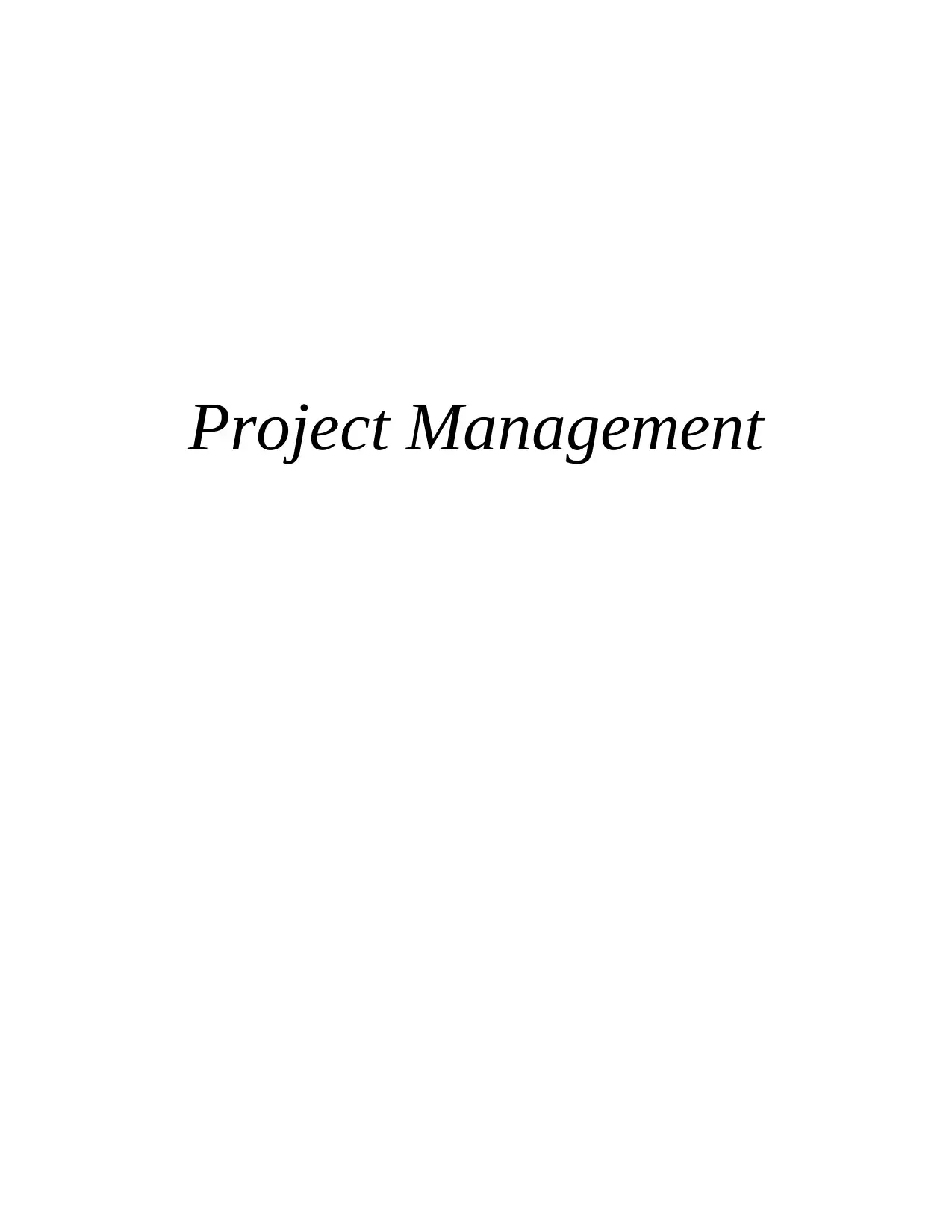
Project Management
Secure Best Marks with AI Grader
Need help grading? Try our AI Grader for instant feedback on your assignments.
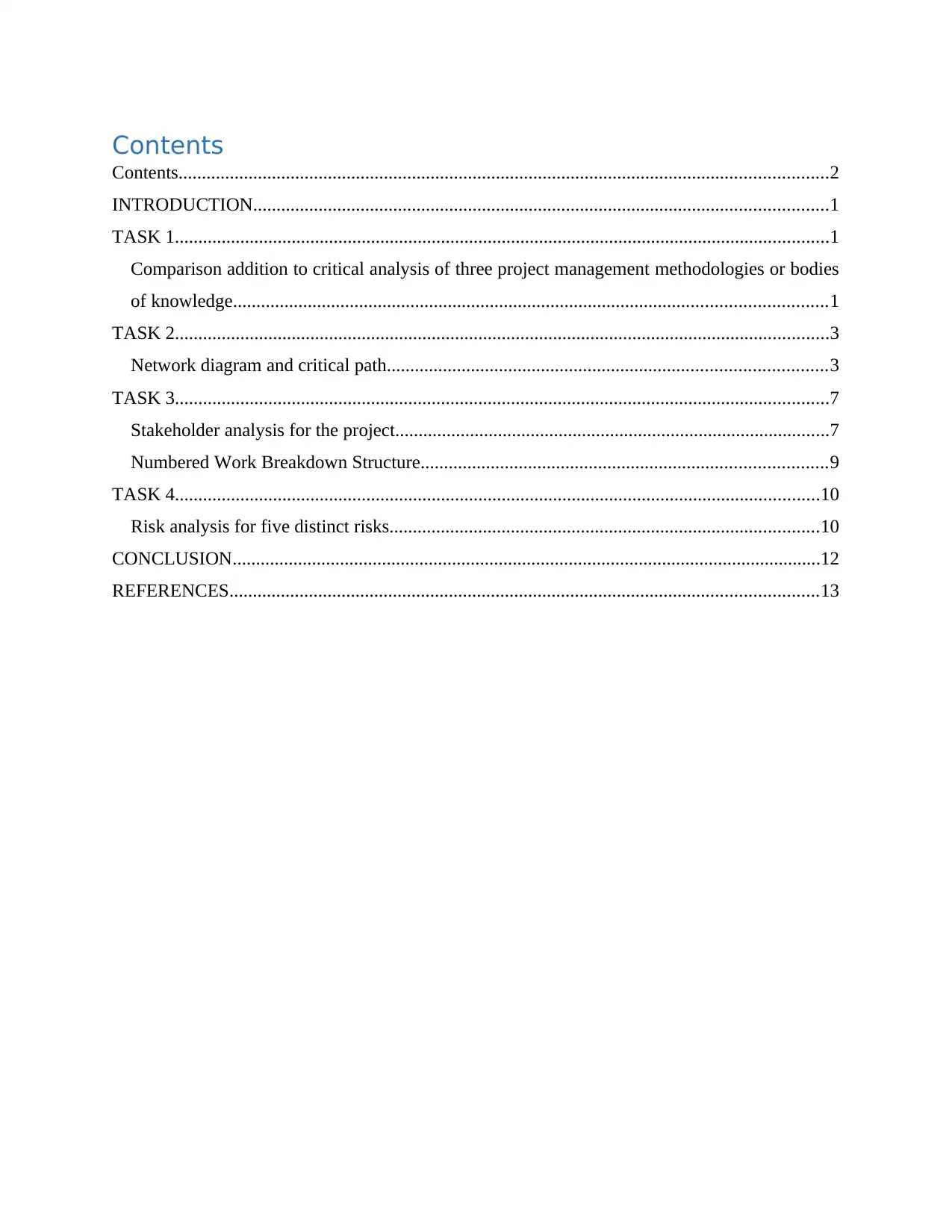
Contents
Contents...........................................................................................................................................2
INTRODUCTION...........................................................................................................................1
TASK 1............................................................................................................................................1
Comparison addition to critical analysis of three project management methodologies or bodies
of knowledge...............................................................................................................................1
TASK 2............................................................................................................................................3
Network diagram and critical path..............................................................................................3
TASK 3............................................................................................................................................7
Stakeholder analysis for the project.............................................................................................7
Numbered Work Breakdown Structure.......................................................................................9
TASK 4..........................................................................................................................................10
Risk analysis for five distinct risks............................................................................................10
CONCLUSION..............................................................................................................................12
REFERENCES..............................................................................................................................13
Contents...........................................................................................................................................2
INTRODUCTION...........................................................................................................................1
TASK 1............................................................................................................................................1
Comparison addition to critical analysis of three project management methodologies or bodies
of knowledge...............................................................................................................................1
TASK 2............................................................................................................................................3
Network diagram and critical path..............................................................................................3
TASK 3............................................................................................................................................7
Stakeholder analysis for the project.............................................................................................7
Numbered Work Breakdown Structure.......................................................................................9
TASK 4..........................................................................................................................................10
Risk analysis for five distinct risks............................................................................................10
CONCLUSION..............................................................................................................................12
REFERENCES..............................................................................................................................13

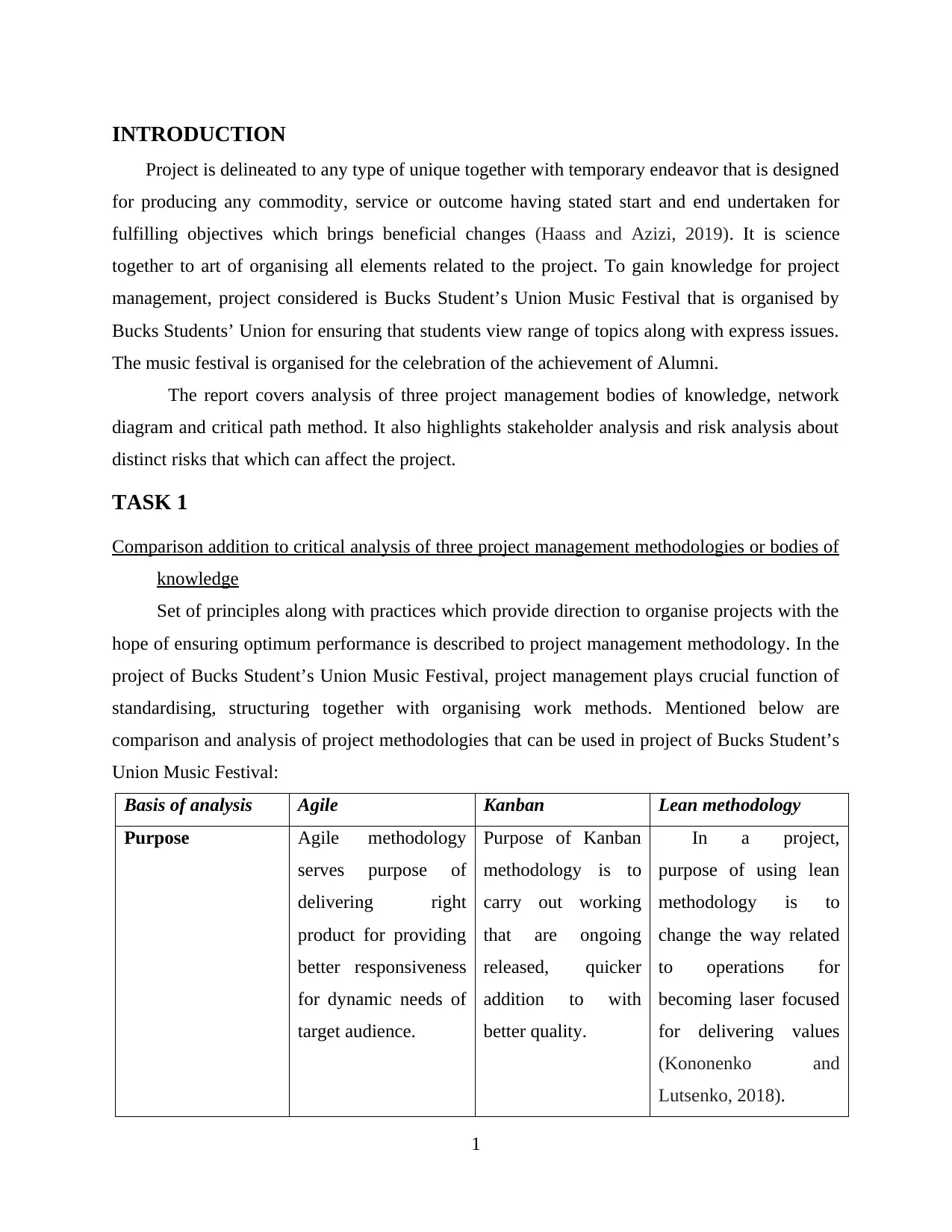
INTRODUCTION
Project is delineated to any type of unique together with temporary endeavor that is designed
for producing any commodity, service or outcome having stated start and end undertaken for
fulfilling objectives which brings beneficial changes (Haass and Azizi, 2019). It is science
together to art of organising all elements related to the project. To gain knowledge for project
management, project considered is Bucks Student’s Union Music Festival that is organised by
Bucks Students’ Union for ensuring that students view range of topics along with express issues.
The music festival is organised for the celebration of the achievement of Alumni.
The report covers analysis of three project management bodies of knowledge, network
diagram and critical path method. It also highlights stakeholder analysis and risk analysis about
distinct risks that which can affect the project.
TASK 1
Comparison addition to critical analysis of three project management methodologies or bodies of
knowledge
Set of principles along with practices which provide direction to organise projects with the
hope of ensuring optimum performance is described to project management methodology. In the
project of Bucks Student’s Union Music Festival, project management plays crucial function of
standardising, structuring together with organising work methods. Mentioned below are
comparison and analysis of project methodologies that can be used in project of Bucks Student’s
Union Music Festival:
Basis of analysis Agile Kanban Lean methodology
Purpose Agile methodology
serves purpose of
delivering right
product for providing
better responsiveness
for dynamic needs of
target audience.
Purpose of Kanban
methodology is to
carry out working
that are ongoing
released, quicker
addition to with
better quality.
In a project,
purpose of using lean
methodology is to
change the way related
to operations for
becoming laser focused
for delivering values
(Kononenko and
Lutsenko, 2018).
1
Project is delineated to any type of unique together with temporary endeavor that is designed
for producing any commodity, service or outcome having stated start and end undertaken for
fulfilling objectives which brings beneficial changes (Haass and Azizi, 2019). It is science
together to art of organising all elements related to the project. To gain knowledge for project
management, project considered is Bucks Student’s Union Music Festival that is organised by
Bucks Students’ Union for ensuring that students view range of topics along with express issues.
The music festival is organised for the celebration of the achievement of Alumni.
The report covers analysis of three project management bodies of knowledge, network
diagram and critical path method. It also highlights stakeholder analysis and risk analysis about
distinct risks that which can affect the project.
TASK 1
Comparison addition to critical analysis of three project management methodologies or bodies of
knowledge
Set of principles along with practices which provide direction to organise projects with the
hope of ensuring optimum performance is described to project management methodology. In the
project of Bucks Student’s Union Music Festival, project management plays crucial function of
standardising, structuring together with organising work methods. Mentioned below are
comparison and analysis of project methodologies that can be used in project of Bucks Student’s
Union Music Festival:
Basis of analysis Agile Kanban Lean methodology
Purpose Agile methodology
serves purpose of
delivering right
product for providing
better responsiveness
for dynamic needs of
target audience.
Purpose of Kanban
methodology is to
carry out working
that are ongoing
released, quicker
addition to with
better quality.
In a project,
purpose of using lean
methodology is to
change the way related
to operations for
becoming laser focused
for delivering values
(Kononenko and
Lutsenko, 2018).
1
Secure Best Marks with AI Grader
Need help grading? Try our AI Grader for instant feedback on your assignments.
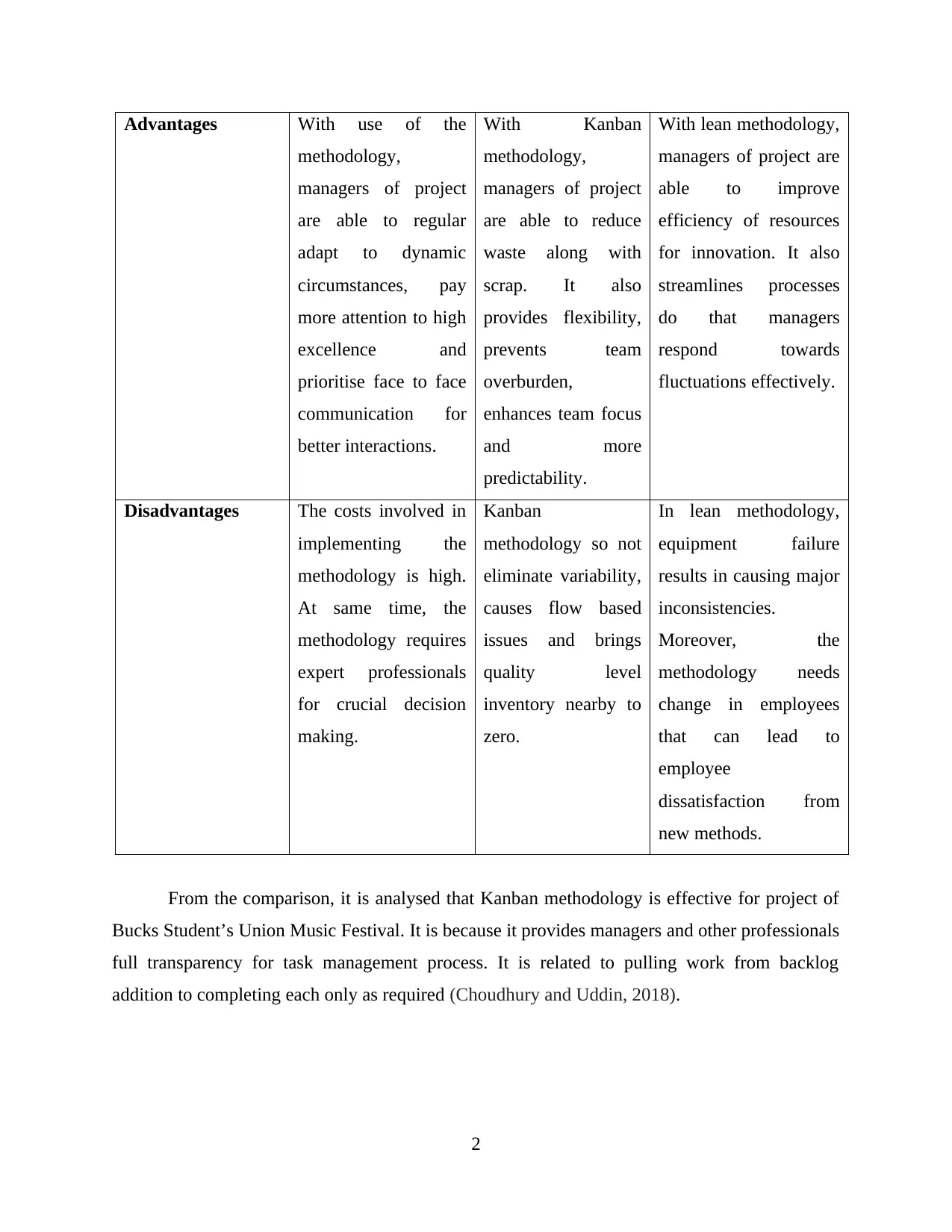
Advantages With use of the
methodology,
managers of project
are able to regular
adapt to dynamic
circumstances, pay
more attention to high
excellence and
prioritise face to face
communication for
better interactions.
With Kanban
methodology,
managers of project
are able to reduce
waste along with
scrap. It also
provides flexibility,
prevents team
overburden,
enhances team focus
and more
predictability.
With lean methodology,
managers of project are
able to improve
efficiency of resources
for innovation. It also
streamlines processes
do that managers
respond towards
fluctuations effectively.
Disadvantages The costs involved in
implementing the
methodology is high.
At same time, the
methodology requires
expert professionals
for crucial decision
making.
Kanban
methodology so not
eliminate variability,
causes flow based
issues and brings
quality level
inventory nearby to
zero.
In lean methodology,
equipment failure
results in causing major
inconsistencies.
Moreover, the
methodology needs
change in employees
that can lead to
employee
dissatisfaction from
new methods.
From the comparison, it is analysed that Kanban methodology is effective for project of
Bucks Student’s Union Music Festival. It is because it provides managers and other professionals
full transparency for task management process. It is related to pulling work from backlog
addition to completing each only as required (Choudhury and Uddin, 2018).
2
methodology,
managers of project
are able to regular
adapt to dynamic
circumstances, pay
more attention to high
excellence and
prioritise face to face
communication for
better interactions.
With Kanban
methodology,
managers of project
are able to reduce
waste along with
scrap. It also
provides flexibility,
prevents team
overburden,
enhances team focus
and more
predictability.
With lean methodology,
managers of project are
able to improve
efficiency of resources
for innovation. It also
streamlines processes
do that managers
respond towards
fluctuations effectively.
Disadvantages The costs involved in
implementing the
methodology is high.
At same time, the
methodology requires
expert professionals
for crucial decision
making.
Kanban
methodology so not
eliminate variability,
causes flow based
issues and brings
quality level
inventory nearby to
zero.
In lean methodology,
equipment failure
results in causing major
inconsistencies.
Moreover, the
methodology needs
change in employees
that can lead to
employee
dissatisfaction from
new methods.
From the comparison, it is analysed that Kanban methodology is effective for project of
Bucks Student’s Union Music Festival. It is because it provides managers and other professionals
full transparency for task management process. It is related to pulling work from backlog
addition to completing each only as required (Choudhury and Uddin, 2018).
2
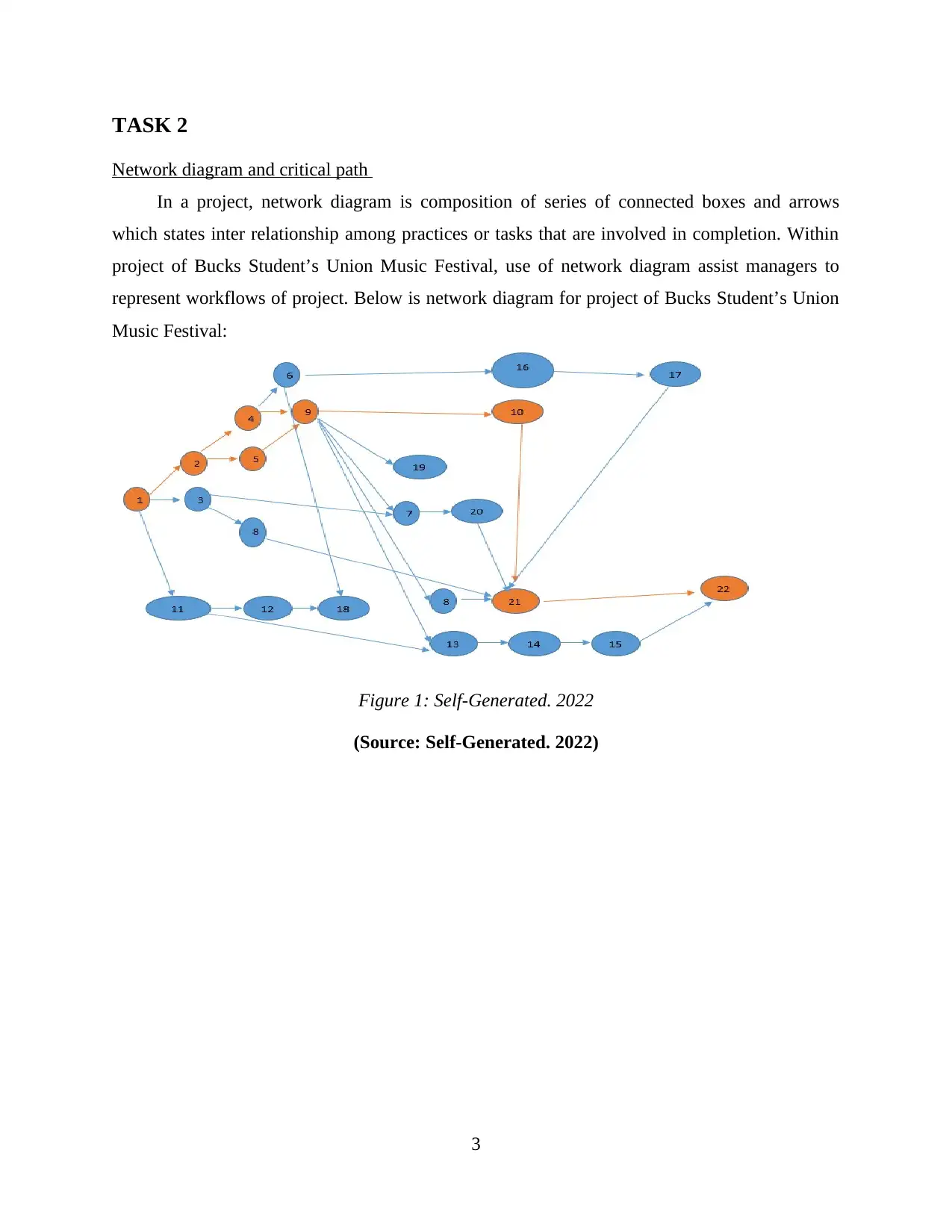
TASK 2
Network diagram and critical path
In a project, network diagram is composition of series of connected boxes and arrows
which states inter relationship among practices or tasks that are involved in completion. Within
project of Bucks Student’s Union Music Festival, use of network diagram assist managers to
represent workflows of project. Below is network diagram for project of Bucks Student’s Union
Music Festival:
Figure 1: Self-Generated. 2022
(Source: Self-Generated. 2022)
3
Network diagram and critical path
In a project, network diagram is composition of series of connected boxes and arrows
which states inter relationship among practices or tasks that are involved in completion. Within
project of Bucks Student’s Union Music Festival, use of network diagram assist managers to
represent workflows of project. Below is network diagram for project of Bucks Student’s Union
Music Festival:
Figure 1: Self-Generated. 2022
(Source: Self-Generated. 2022)
3
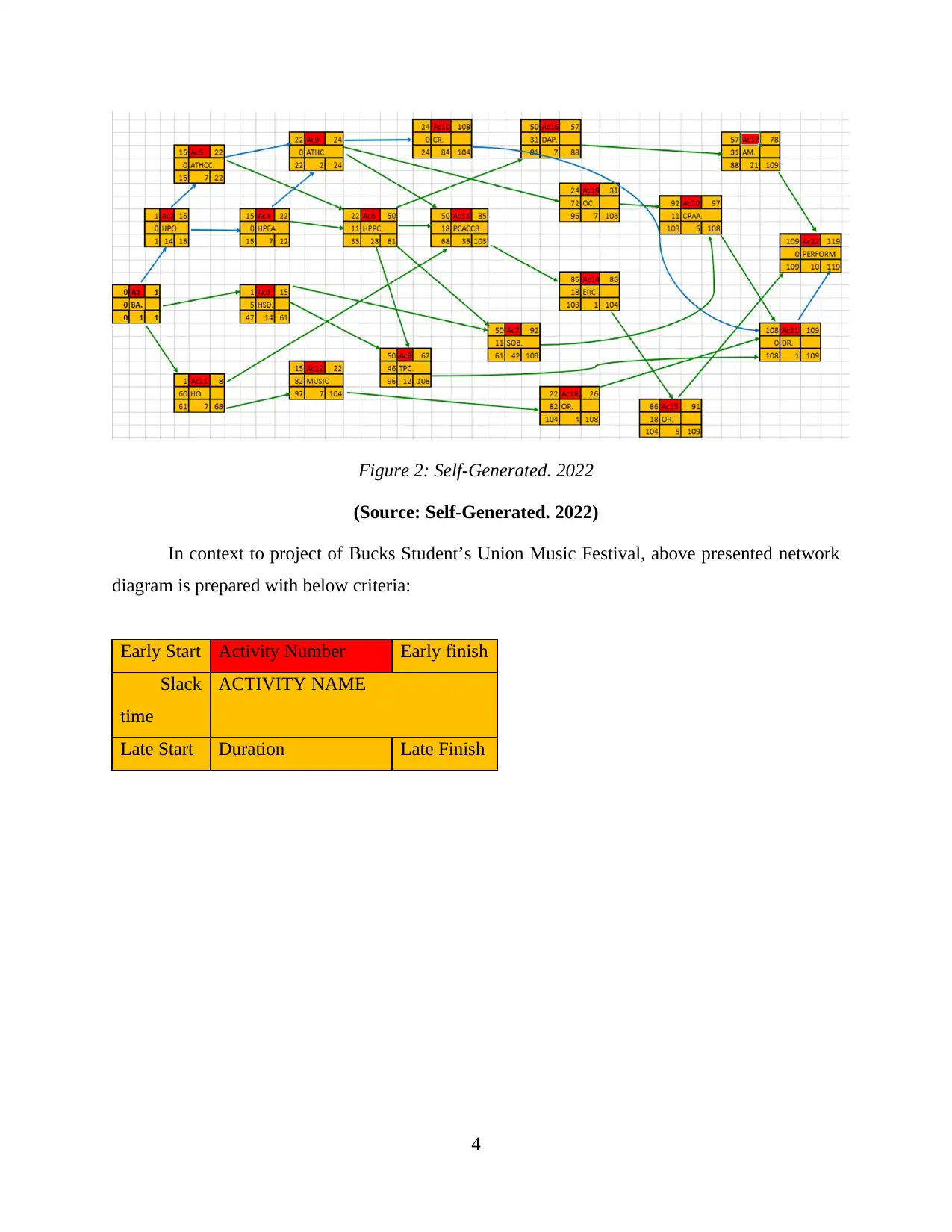
Figure 2: Self-Generated. 2022
(Source: Self-Generated. 2022)
In context to project of Bucks Student’s Union Music Festival, above presented network
diagram is prepared with below criteria:
Early Start Activity Number Early finish
Slack
time
ACTIVITY NAME
Late Start Duration Late Finish
4
(Source: Self-Generated. 2022)
In context to project of Bucks Student’s Union Music Festival, above presented network
diagram is prepared with below criteria:
Early Start Activity Number Early finish
Slack
time
ACTIVITY NAME
Late Start Duration Late Finish
4
Paraphrase This Document
Need a fresh take? Get an instant paraphrase of this document with our AI Paraphraser
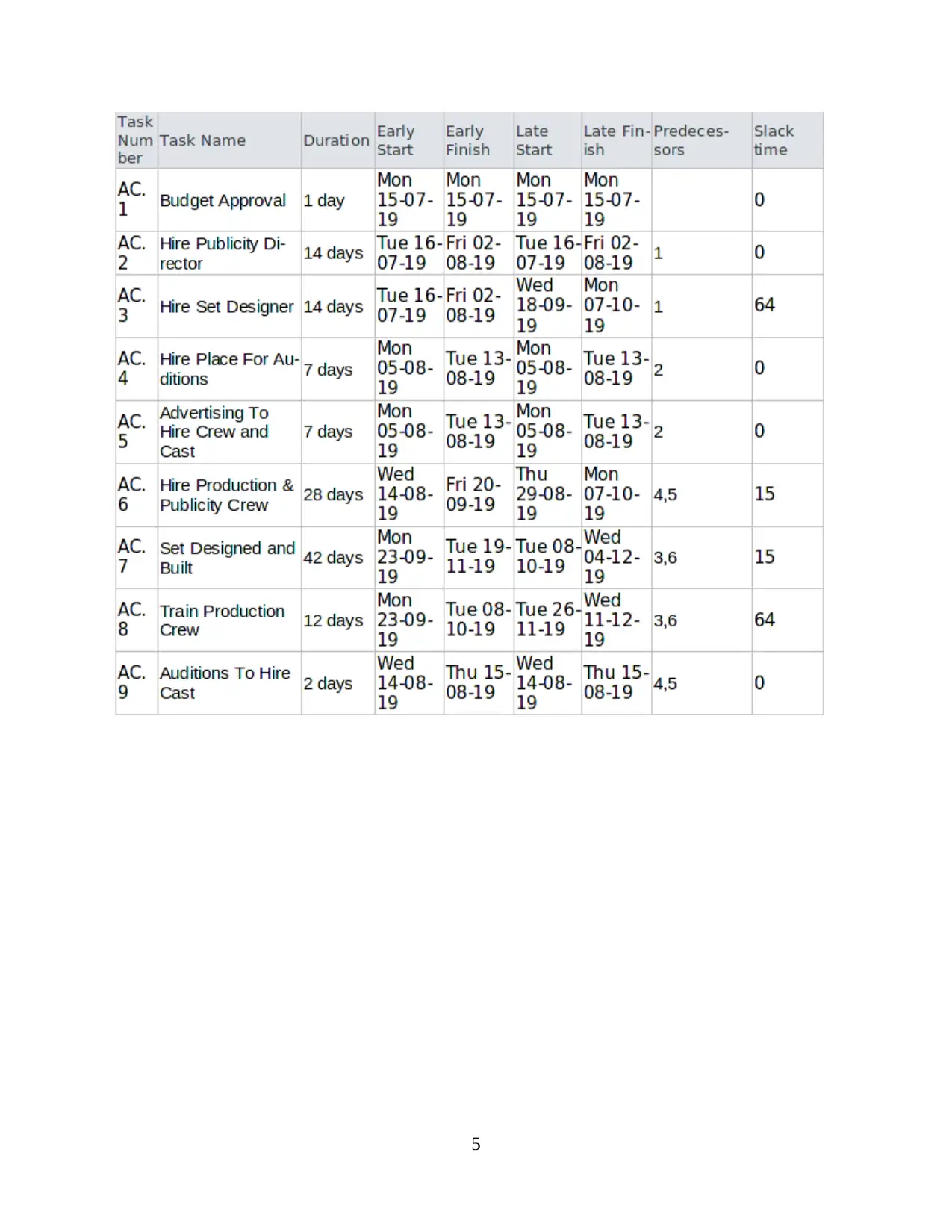
5
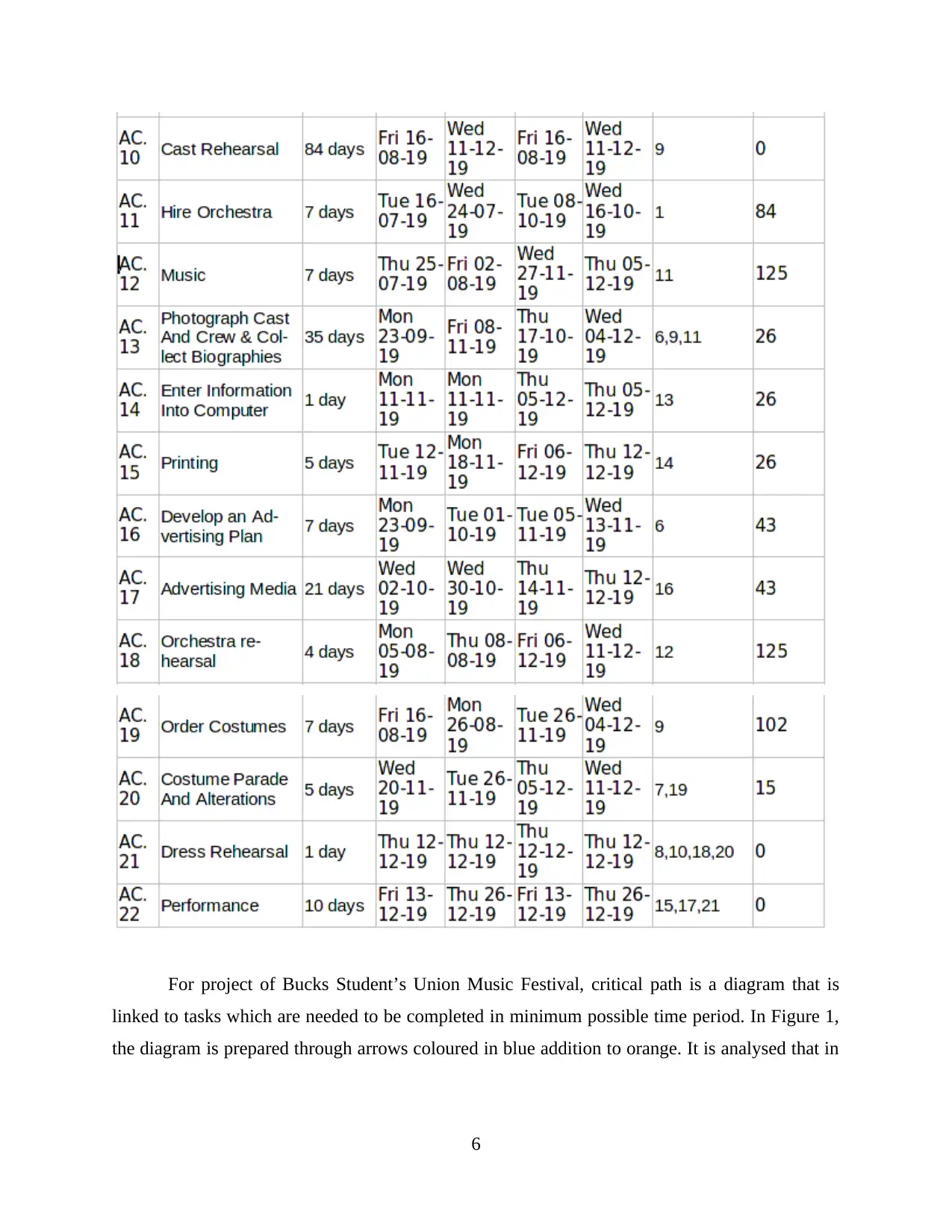
For project of Bucks Student’s Union Music Festival, critical path is a diagram that is
linked to tasks which are needed to be completed in minimum possible time period. In Figure 1,
the diagram is prepared through arrows coloured in blue addition to orange. It is analysed that in
6
linked to tasks which are needed to be completed in minimum possible time period. In Figure 1,
the diagram is prepared through arrows coloured in blue addition to orange. It is analysed that in
6
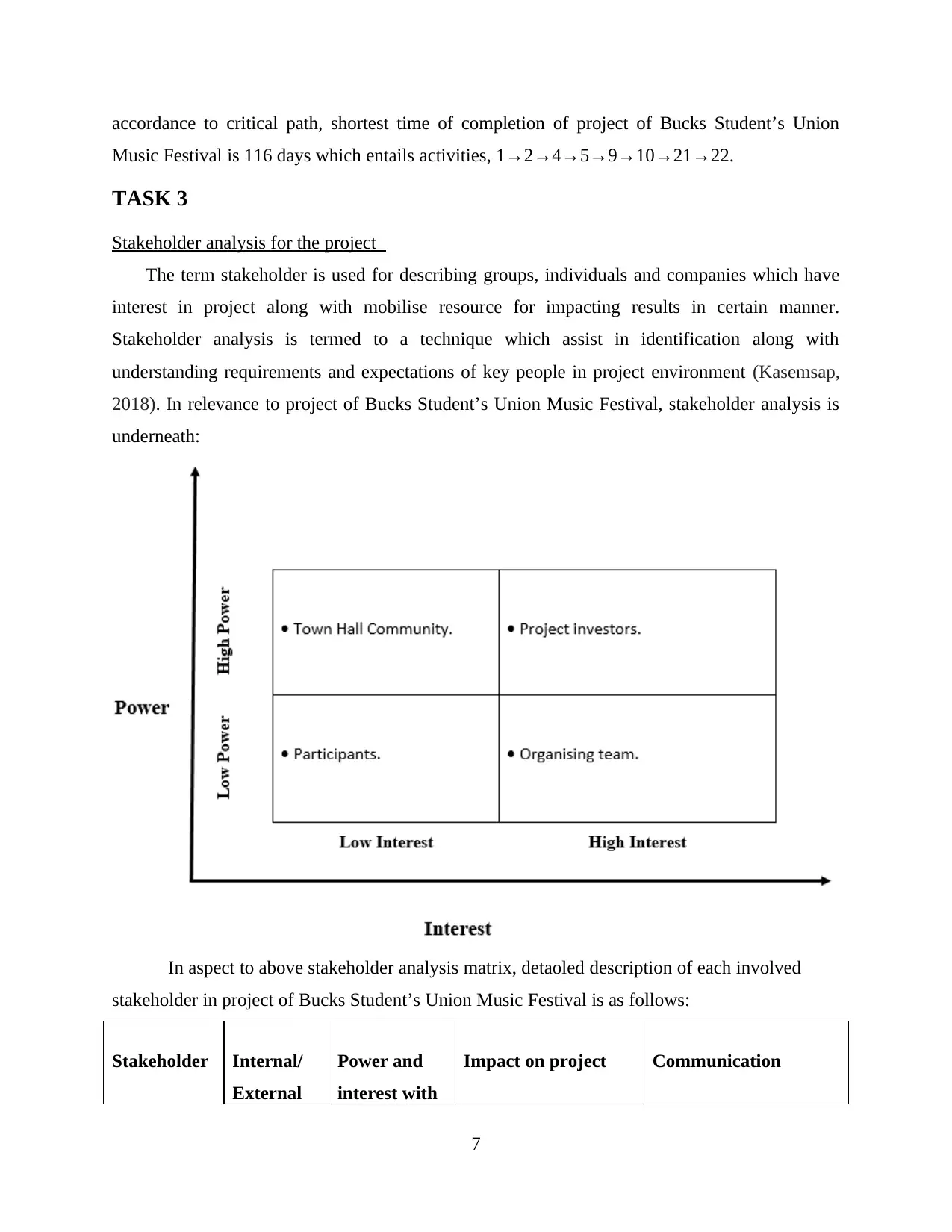
accordance to critical path, shortest time of completion of project of Bucks Student’s Union
Music Festival is 116 days which entails activities, 1→2→4→5→9→10→21→22.
TASK 3
Stakeholder analysis for the project
The term stakeholder is used for describing groups, individuals and companies which have
interest in project along with mobilise resource for impacting results in certain manner.
Stakeholder analysis is termed to a technique which assist in identification along with
understanding requirements and expectations of key people in project environment (Kasemsap,
2018). In relevance to project of Bucks Student’s Union Music Festival, stakeholder analysis is
underneath:
In aspect to above stakeholder analysis matrix, detaoled description of each involved
stakeholder in project of Bucks Student’s Union Music Festival is as follows:
Stakeholder Internal/
External
Power and
interest with
Impact on project Communication
7
Music Festival is 116 days which entails activities, 1→2→4→5→9→10→21→22.
TASK 3
Stakeholder analysis for the project
The term stakeholder is used for describing groups, individuals and companies which have
interest in project along with mobilise resource for impacting results in certain manner.
Stakeholder analysis is termed to a technique which assist in identification along with
understanding requirements and expectations of key people in project environment (Kasemsap,
2018). In relevance to project of Bucks Student’s Union Music Festival, stakeholder analysis is
underneath:
In aspect to above stakeholder analysis matrix, detaoled description of each involved
stakeholder in project of Bucks Student’s Union Music Festival is as follows:
Stakeholder Internal/
External
Power and
interest with
Impact on project Communication
7
Secure Best Marks with AI Grader
Need help grading? Try our AI Grader for instant feedback on your assignments.
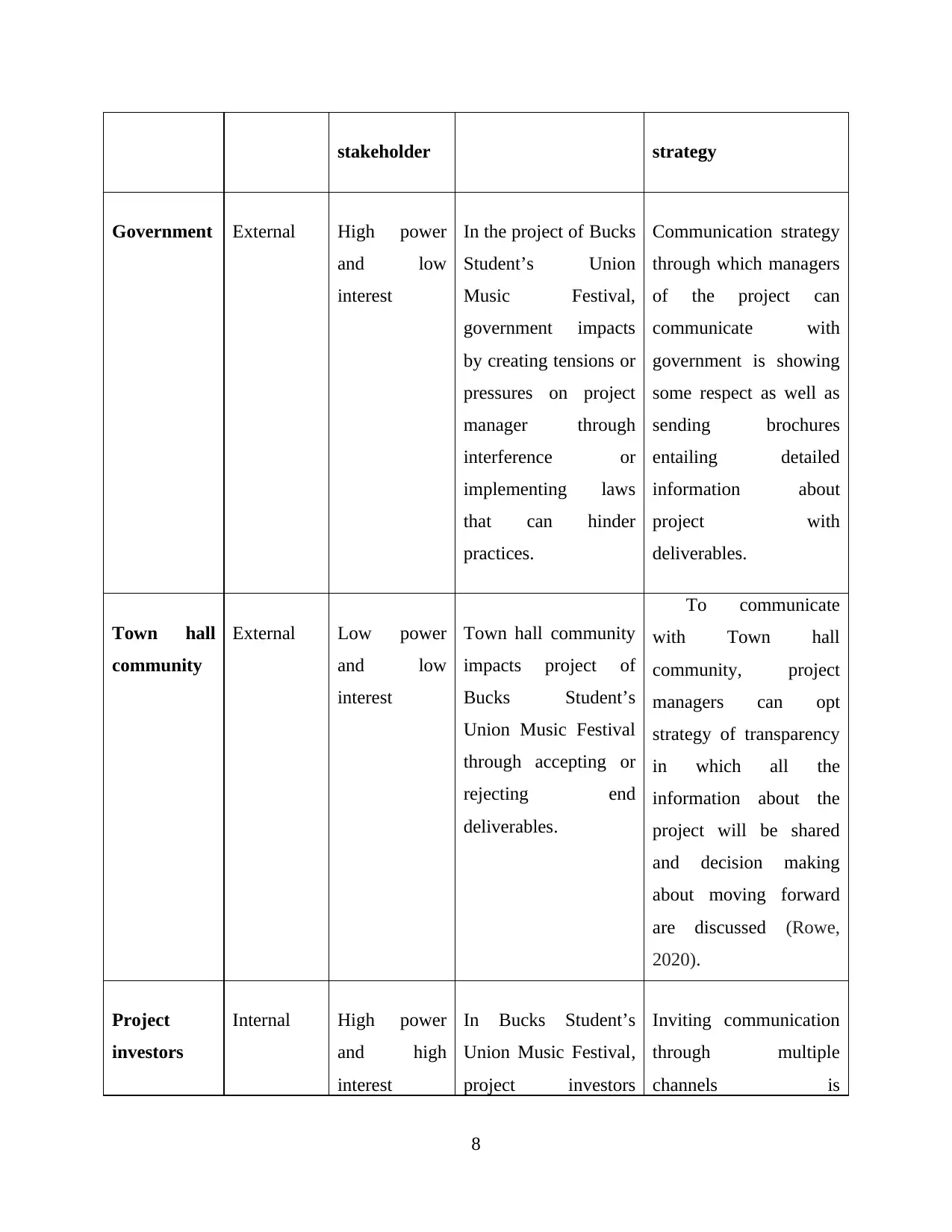
stakeholder strategy
Government External High power
and low
interest
In the project of Bucks
Student’s Union
Music Festival,
government impacts
by creating tensions or
pressures on project
manager through
interference or
implementing laws
that can hinder
practices.
Communication strategy
through which managers
of the project can
communicate with
government is showing
some respect as well as
sending brochures
entailing detailed
information about
project with
deliverables.
Town hall
community
External Low power
and low
interest
Town hall community
impacts project of
Bucks Student’s
Union Music Festival
through accepting or
rejecting end
deliverables.
To communicate
with Town hall
community, project
managers can opt
strategy of transparency
in which all the
information about the
project will be shared
and decision making
about moving forward
are discussed (Rowe,
2020).
Project
investors
Internal High power
and high
interest
In Bucks Student’s
Union Music Festival,
project investors
Inviting communication
through multiple
channels is
8
Government External High power
and low
interest
In the project of Bucks
Student’s Union
Music Festival,
government impacts
by creating tensions or
pressures on project
manager through
interference or
implementing laws
that can hinder
practices.
Communication strategy
through which managers
of the project can
communicate with
government is showing
some respect as well as
sending brochures
entailing detailed
information about
project with
deliverables.
Town hall
community
External Low power
and low
interest
Town hall community
impacts project of
Bucks Student’s
Union Music Festival
through accepting or
rejecting end
deliverables.
To communicate
with Town hall
community, project
managers can opt
strategy of transparency
in which all the
information about the
project will be shared
and decision making
about moving forward
are discussed (Rowe,
2020).
Project
investors
Internal High power
and high
interest
In Bucks Student’s
Union Music Festival,
project investors
Inviting communication
through multiple
channels is
8
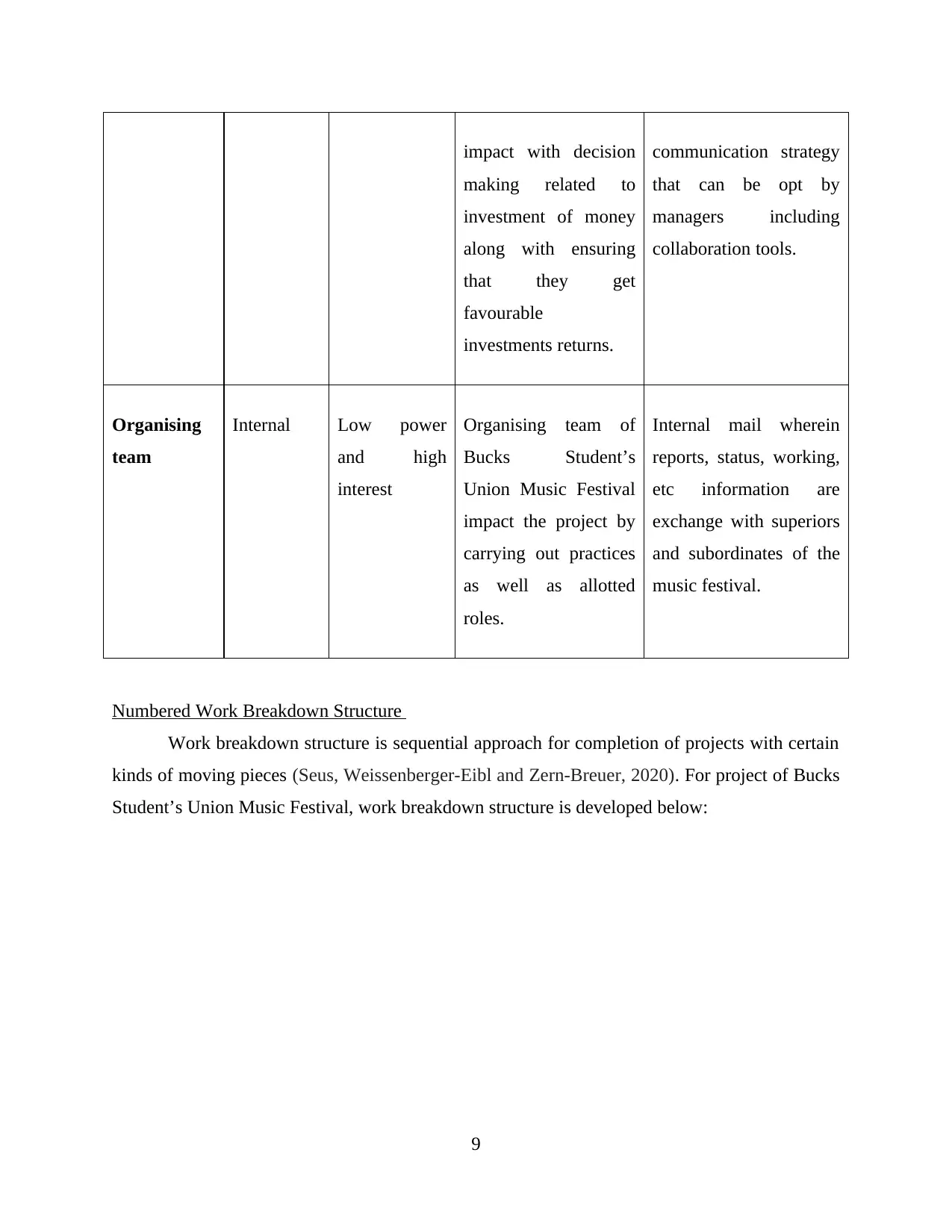
impact with decision
making related to
investment of money
along with ensuring
that they get
favourable
investments returns.
communication strategy
that can be opt by
managers including
collaboration tools.
Organising
team
Internal Low power
and high
interest
Organising team of
Bucks Student’s
Union Music Festival
impact the project by
carrying out practices
as well as allotted
roles.
Internal mail wherein
reports, status, working,
etc information are
exchange with superiors
and subordinates of the
music festival.
Numbered Work Breakdown Structure
Work breakdown structure is sequential approach for completion of projects with certain
kinds of moving pieces (Seus, Weissenberger-Eibl and Zern-Breuer, 2020). For project of Bucks
Student’s Union Music Festival, work breakdown structure is developed below:
9
making related to
investment of money
along with ensuring
that they get
favourable
investments returns.
communication strategy
that can be opt by
managers including
collaboration tools.
Organising
team
Internal Low power
and high
interest
Organising team of
Bucks Student’s
Union Music Festival
impact the project by
carrying out practices
as well as allotted
roles.
Internal mail wherein
reports, status, working,
etc information are
exchange with superiors
and subordinates of the
music festival.
Numbered Work Breakdown Structure
Work breakdown structure is sequential approach for completion of projects with certain
kinds of moving pieces (Seus, Weissenberger-Eibl and Zern-Breuer, 2020). For project of Bucks
Student’s Union Music Festival, work breakdown structure is developed below:
9
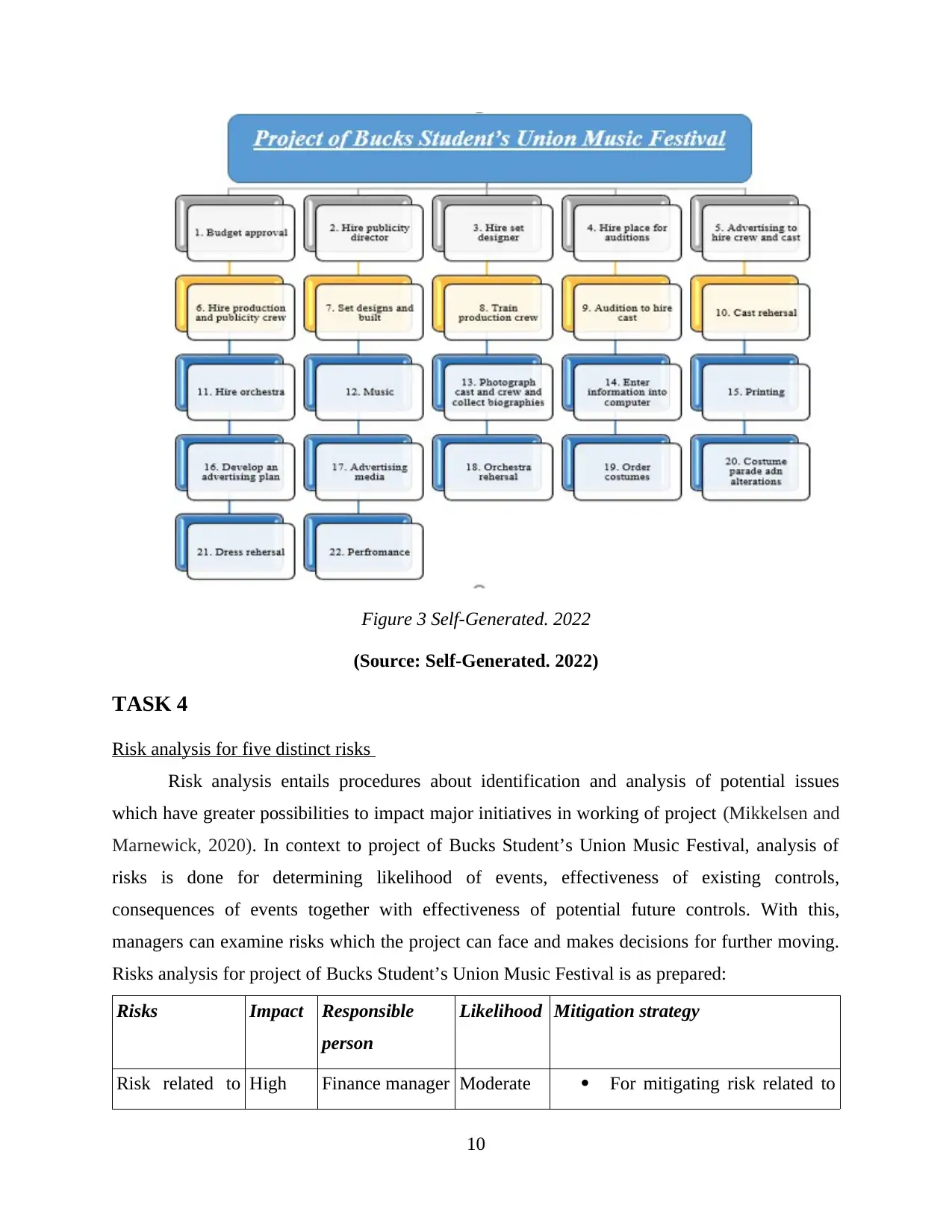
Figure 3 Self-Generated. 2022
(Source: Self-Generated. 2022)
TASK 4
Risk analysis for five distinct risks
Risk analysis entails procedures about identification and analysis of potential issues
which have greater possibilities to impact major initiatives in working of project (Mikkelsen and
Marnewick, 2020). In context to project of Bucks Student’s Union Music Festival, analysis of
risks is done for determining likelihood of events, effectiveness of existing controls,
consequences of events together with effectiveness of potential future controls. With this,
managers can examine risks which the project can face and makes decisions for further moving.
Risks analysis for project of Bucks Student’s Union Music Festival is as prepared:
Risks Impact Responsible
person
Likelihood Mitigation strategy
Risk related to High Finance manager Moderate For mitigating risk related to
10
(Source: Self-Generated. 2022)
TASK 4
Risk analysis for five distinct risks
Risk analysis entails procedures about identification and analysis of potential issues
which have greater possibilities to impact major initiatives in working of project (Mikkelsen and
Marnewick, 2020). In context to project of Bucks Student’s Union Music Festival, analysis of
risks is done for determining likelihood of events, effectiveness of existing controls,
consequences of events together with effectiveness of potential future controls. With this,
managers can examine risks which the project can face and makes decisions for further moving.
Risks analysis for project of Bucks Student’s Union Music Festival is as prepared:
Risks Impact Responsible
person
Likelihood Mitigation strategy
Risk related to High Finance manager Moderate For mitigating risk related to
10
Paraphrase This Document
Need a fresh take? Get an instant paraphrase of this document with our AI Paraphraser
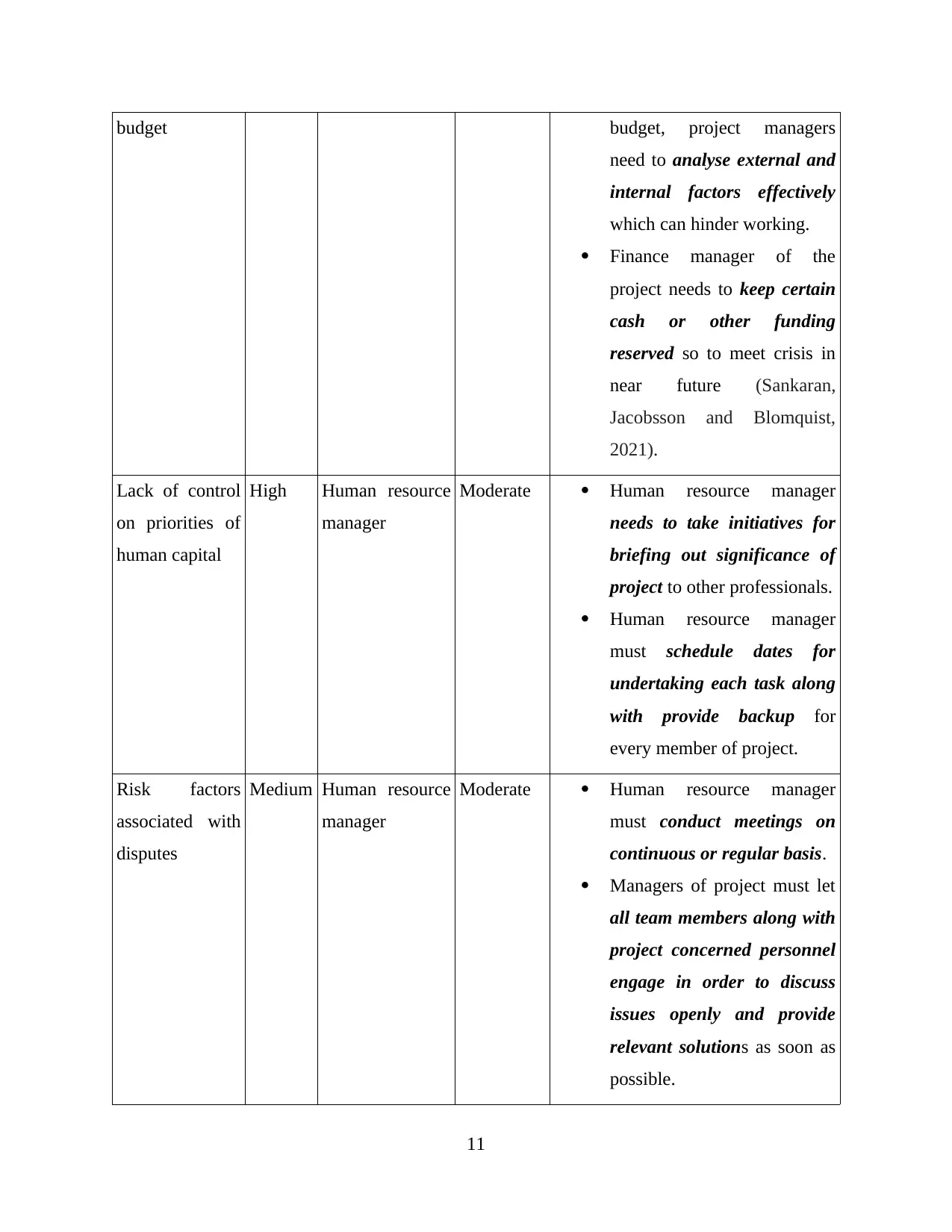
budget budget, project managers
need to analyse external and
internal factors effectively
which can hinder working.
Finance manager of the
project needs to keep certain
cash or other funding
reserved so to meet crisis in
near future (Sankaran,
Jacobsson and Blomquist,
2021).
Lack of control
on priorities of
human capital
High Human resource
manager
Moderate Human resource manager
needs to take initiatives for
briefing out significance of
project to other professionals.
Human resource manager
must schedule dates for
undertaking each task along
with provide backup for
every member of project.
Risk factors
associated with
disputes
Medium Human resource
manager
Moderate Human resource manager
must conduct meetings on
continuous or regular basis.
Managers of project must let
all team members along with
project concerned personnel
engage in order to discuss
issues openly and provide
relevant solutions as soon as
possible.
11
need to analyse external and
internal factors effectively
which can hinder working.
Finance manager of the
project needs to keep certain
cash or other funding
reserved so to meet crisis in
near future (Sankaran,
Jacobsson and Blomquist,
2021).
Lack of control
on priorities of
human capital
High Human resource
manager
Moderate Human resource manager
needs to take initiatives for
briefing out significance of
project to other professionals.
Human resource manager
must schedule dates for
undertaking each task along
with provide backup for
every member of project.
Risk factors
associated with
disputes
Medium Human resource
manager
Moderate Human resource manager
must conduct meetings on
continuous or regular basis.
Managers of project must let
all team members along with
project concerned personnel
engage in order to discuss
issues openly and provide
relevant solutions as soon as
possible.
11
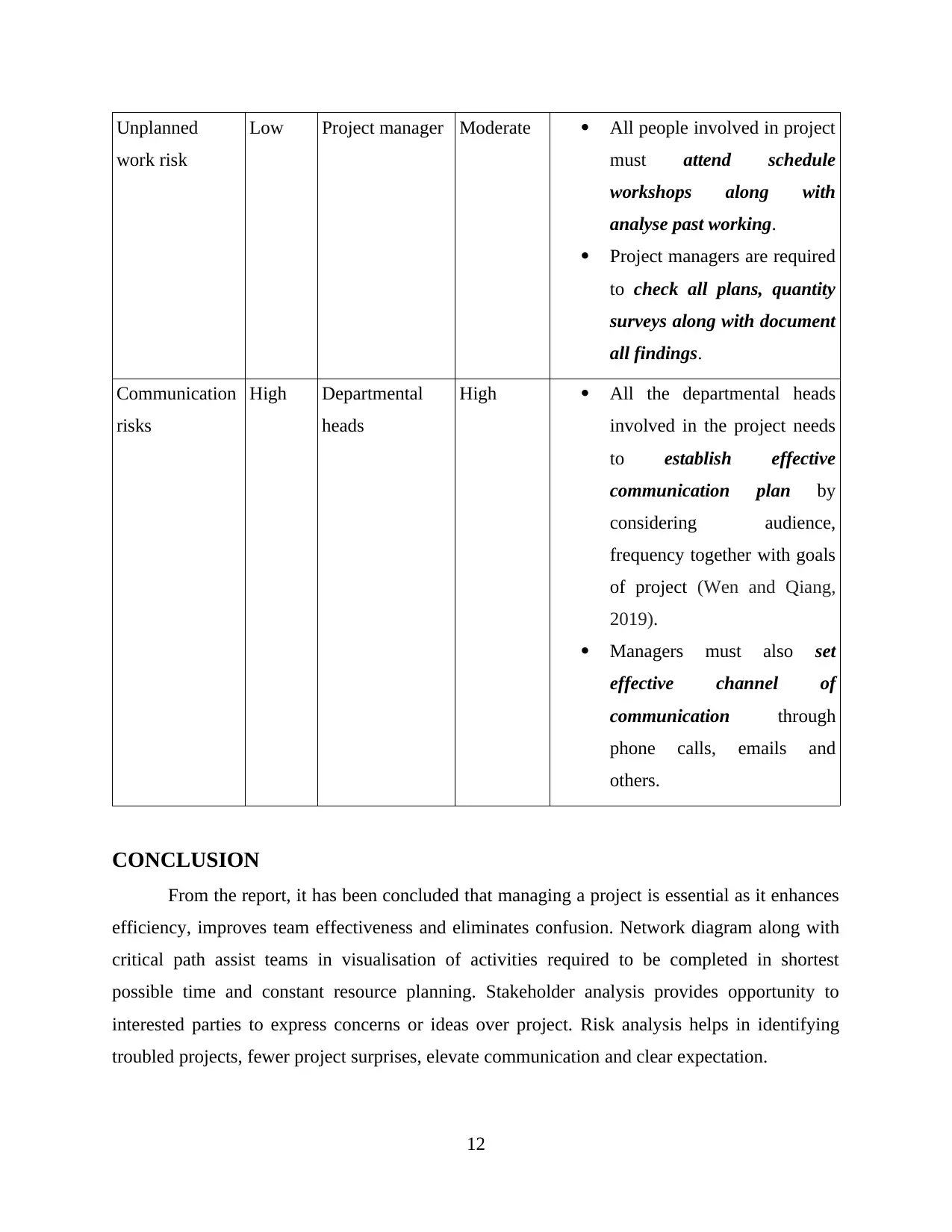
Unplanned
work risk
Low Project manager Moderate All people involved in project
must attend schedule
workshops along with
analyse past working.
Project managers are required
to check all plans, quantity
surveys along with document
all findings.
Communication
risks
High Departmental
heads
High All the departmental heads
involved in the project needs
to establish effective
communication plan by
considering audience,
frequency together with goals
of project (Wen and Qiang,
2019).
Managers must also set
effective channel of
communication through
phone calls, emails and
others.
CONCLUSION
From the report, it has been concluded that managing a project is essential as it enhances
efficiency, improves team effectiveness and eliminates confusion. Network diagram along with
critical path assist teams in visualisation of activities required to be completed in shortest
possible time and constant resource planning. Stakeholder analysis provides opportunity to
interested parties to express concerns or ideas over project. Risk analysis helps in identifying
troubled projects, fewer project surprises, elevate communication and clear expectation.
12
work risk
Low Project manager Moderate All people involved in project
must attend schedule
workshops along with
analyse past working.
Project managers are required
to check all plans, quantity
surveys along with document
all findings.
Communication
risks
High Departmental
heads
High All the departmental heads
involved in the project needs
to establish effective
communication plan by
considering audience,
frequency together with goals
of project (Wen and Qiang,
2019).
Managers must also set
effective channel of
communication through
phone calls, emails and
others.
CONCLUSION
From the report, it has been concluded that managing a project is essential as it enhances
efficiency, improves team effectiveness and eliminates confusion. Network diagram along with
critical path assist teams in visualisation of activities required to be completed in shortest
possible time and constant resource planning. Stakeholder analysis provides opportunity to
interested parties to express concerns or ideas over project. Risk analysis helps in identifying
troubled projects, fewer project surprises, elevate communication and clear expectation.
12
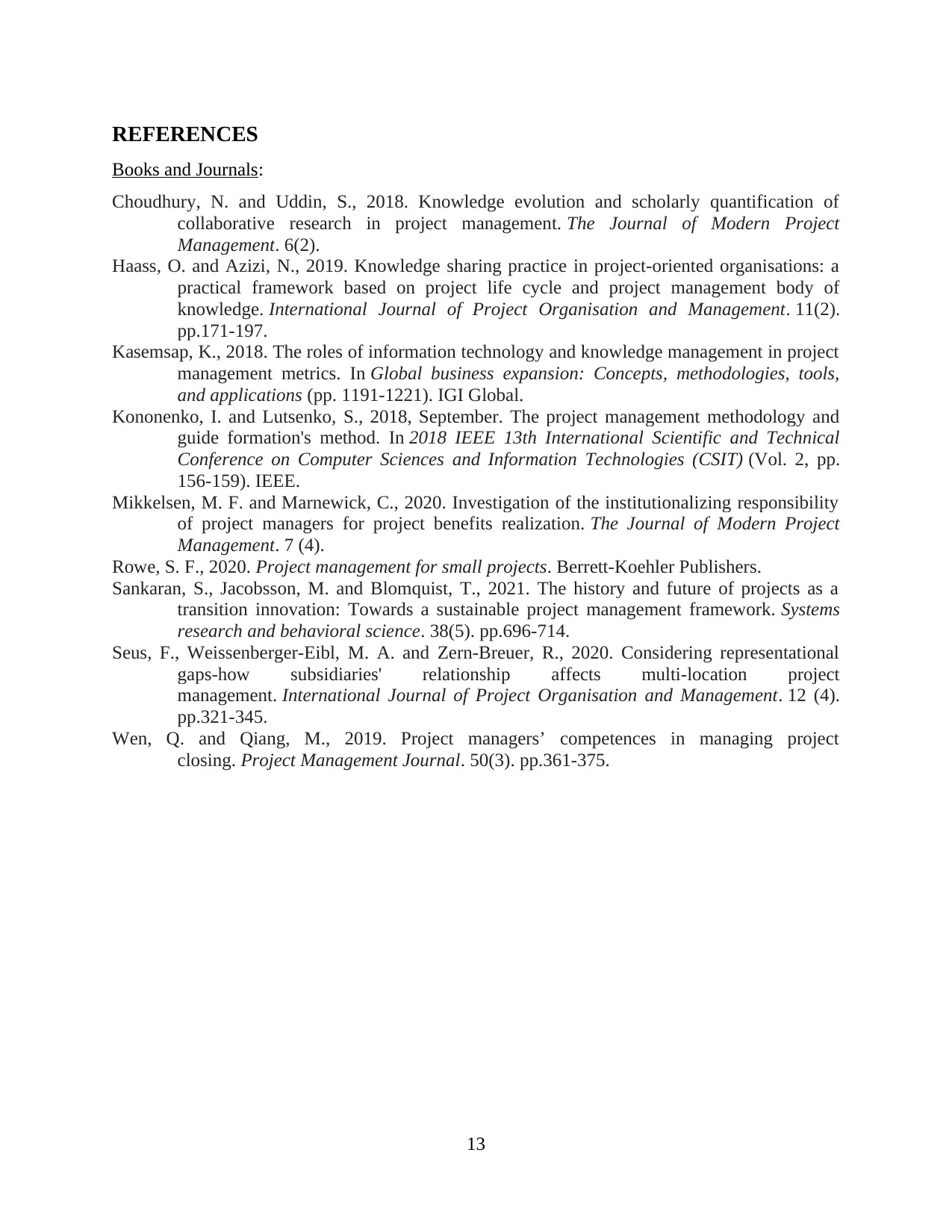
REFERENCES
Books and Journals:
Choudhury, N. and Uddin, S., 2018. Knowledge evolution and scholarly quantification of
collaborative research in project management. The Journal of Modern Project
Management. 6(2).
Haass, O. and Azizi, N., 2019. Knowledge sharing practice in project-oriented organisations: a
practical framework based on project life cycle and project management body of
knowledge. International Journal of Project Organisation and Management. 11(2).
pp.171-197.
Kasemsap, K., 2018. The roles of information technology and knowledge management in project
management metrics. In Global business expansion: Concepts, methodologies, tools,
and applications (pp. 1191-1221). IGI Global.
Kononenko, I. and Lutsenko, S., 2018, September. The project management methodology and
guide formation's method. In 2018 IEEE 13th International Scientific and Technical
Conference on Computer Sciences and Information Technologies (CSIT) (Vol. 2, pp.
156-159). IEEE.
Mikkelsen, M. F. and Marnewick, C., 2020. Investigation of the institutionalizing responsibility
of project managers for project benefits realization. The Journal of Modern Project
Management. 7 (4).
Rowe, S. F., 2020. Project management for small projects. Berrett-Koehler Publishers.
Sankaran, S., Jacobsson, M. and Blomquist, T., 2021. The history and future of projects as a
transition innovation: Towards a sustainable project management framework. Systems
research and behavioral science. 38(5). pp.696-714.
Seus, F., Weissenberger-Eibl, M. A. and Zern-Breuer, R., 2020. Considering representational
gaps-how subsidiaries' relationship affects multi-location project
management. International Journal of Project Organisation and Management. 12 (4).
pp.321-345.
Wen, Q. and Qiang, M., 2019. Project managers’ competences in managing project
closing. Project Management Journal. 50(3). pp.361-375.
13
Books and Journals:
Choudhury, N. and Uddin, S., 2018. Knowledge evolution and scholarly quantification of
collaborative research in project management. The Journal of Modern Project
Management. 6(2).
Haass, O. and Azizi, N., 2019. Knowledge sharing practice in project-oriented organisations: a
practical framework based on project life cycle and project management body of
knowledge. International Journal of Project Organisation and Management. 11(2).
pp.171-197.
Kasemsap, K., 2018. The roles of information technology and knowledge management in project
management metrics. In Global business expansion: Concepts, methodologies, tools,
and applications (pp. 1191-1221). IGI Global.
Kononenko, I. and Lutsenko, S., 2018, September. The project management methodology and
guide formation's method. In 2018 IEEE 13th International Scientific and Technical
Conference on Computer Sciences and Information Technologies (CSIT) (Vol. 2, pp.
156-159). IEEE.
Mikkelsen, M. F. and Marnewick, C., 2020. Investigation of the institutionalizing responsibility
of project managers for project benefits realization. The Journal of Modern Project
Management. 7 (4).
Rowe, S. F., 2020. Project management for small projects. Berrett-Koehler Publishers.
Sankaran, S., Jacobsson, M. and Blomquist, T., 2021. The history and future of projects as a
transition innovation: Towards a sustainable project management framework. Systems
research and behavioral science. 38(5). pp.696-714.
Seus, F., Weissenberger-Eibl, M. A. and Zern-Breuer, R., 2020. Considering representational
gaps-how subsidiaries' relationship affects multi-location project
management. International Journal of Project Organisation and Management. 12 (4).
pp.321-345.
Wen, Q. and Qiang, M., 2019. Project managers’ competences in managing project
closing. Project Management Journal. 50(3). pp.361-375.
13
1 out of 16
Related Documents
Your All-in-One AI-Powered Toolkit for Academic Success.
+13062052269
info@desklib.com
Available 24*7 on WhatsApp / Email
![[object Object]](/_next/static/media/star-bottom.7253800d.svg)
Unlock your academic potential
© 2024 | Zucol Services PVT LTD | All rights reserved.




